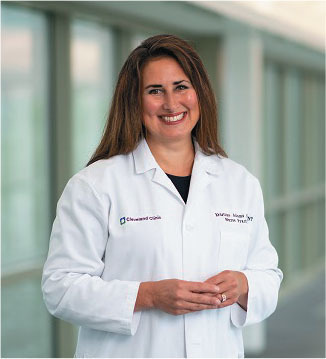
A Conversation with Kristine Weiss Adams, MSN, CNP
BY , DNP, ACNS-BC, NEA-BC, CCM
Each month, we will look at a case management leader recommended by one of our past CMSA presidents. Each one has contributed to the practice of case management and inspired others to step up and become leaders in their area of case management.
In this issue, Past President of the Case Management Society of America Mary McLaughlin Davis, DNP, ACNS-BC, NEA-BC, CCM, senior director, care management, Cleveland Clinic, recommends Kristine Weiss Adams, MSN, CNP, the associate chief nursing officer, care management and ambulatory services for the Cleveland Clinic Health System. Here are a few questions that will give you insight into this dynamic leader.
Q. WHAT IS YOUR CURRENT ROLE?
A. I am the associate chief nursing officer, care management and ambulatory services for the Cleveland Clinic Health System. (In her role, she directs direct care management, care coordination, ambulatory nursing, home care, hospice, and post-acute nursing practice. She is responsible for oversight of quality, safety, regulatory compliance and operational activities, and collaborates with executive leadership in the development and implementation of strategic operations.)
Q. WHAT IS THE MODEL OF CASE MANAGEMENT YOUR ORGANIZATION FOLLOWS?
A. Our model for the past 5 years has been the Integrated Care Model. In this model social workers and nurses work together to achieve the best transition of care for the patient. However, COVID has challenged us to look differently at the roles, functions and activities of our case managers. Redesigning our work so that it is safe, touches the most patients and continues to be impactful is the challenge before us in 2021. Patients’ needs have changed due to consistently higher medical complexity and increasing struggles around the social determinants of health. In addition, the organizational needs have also been altered as it relates to meeting the testing, vaccinating and management of patients in a pandemic. As with many organizations, business and service lines have altered, and budgets are under great constraints. Never before has “do more with less” been more true. As it relates to organizational needs, those organizations who have had a value-based model rather than fee-for-service payment models have fared much better in this climate. The need to reduce the overall cost of care continues to be a strategy to keep hospitals viable in this difficult climate. We must provide for solid transitions of care to reduce readmissions, increased efficiencies, create the ability to touch more patients, improve access to telemedicine and offer programs and strategies around difficult populations such as the homeless, behavioral health and dialysis. Seamless integration between hospital to home, hospital to home care, hospital to facility, hospital to ambulatory need to remain connected – easy to say but not easy to achieve. Models that worked a year ago need to be changed and adapted to today’s healthcare landscape. We are in the process now of looking at everything and redesigning care for a post-pandemic world.
Q. WHAT HAS BEEN YOUR APPROACH TO HAVE YOUR CASE MANAGEMENT TEAM RECOGNIZED FOR THE WORK THEY DO BY YOUR LEADERSHIP?
A. Care management in our organization is often front and center of every initiative. The functions of care management influence so many organizational metrics such as length of stay, readmissions related to transitions of care, discharge HCAHPS, correct statusing of patients, concurrent denials, and others. The care management teams across our enterprise are encouraged to lead from the front and be the expert guidance in these spaces. Each day they report out in our daily huddles preventable readmissions and countermeasures to prevent another readmission. Because of their success, they have been an invaluable member of the clinical team and are included in every hospital C-suite to lend their expertise. They earn their deserved respect and recognition from their multidisciplinary colleagues they serve with.
We also have the opportunity each Nurses Week to recognize individually both social workers and nurses who have excelled in their specialty of case management. These awards afford us the opportunity to highlight their contributions to the medical teams as well as to this valued specialty.
Q. HOW DO YOU MENTOR LEADERS IN YOUR DEPARTMENT?
A. Case management is not a static specialty; in fact it is dynamic, with shifting patient needs, organizational needs and payor contracting changes. With so much tenure and experience, our leaders mentor each other, often coming together across the system to discuss these ever-changing issues and learn from each other’s experiences. We encourage our front-line case management staff to bring forward cases they are struggling with at a formalized meeting we call the Escalation Team Meeting every two weeks. At this meeting cases are presented where there are barriers to a safe discharge plan. Using all our expertise, and including bioethics, legal, ombudsman, and finance on the team, we share ideas and help our front-line staff get to a resolution. This also gives our staff an opportunity to learn how to formally present a case concisely and improves communication skills. Similarly, we do case study presentations at our UM meetings. In a spirit of “what could we have done better” we review cases and discuss with managers and leaders aspects and opportunities for improvement.
Q. HOW IS THE MORALE OF YOUR WORKFORCE?
A. Understandably, they are tired. The toll of the pandemic creating high censuses, children not in school, lockdowns, as well as personal health challenges with COVID have left them overworked, overwhelmed and understaffed. In our organization we are lucky to have the resources to help our staff in times of illness including sending meals through Grubhub, helping with childcare issues and generous PTO policies. All these things still don’t eliminate the stress and drains on their resilience. This spring, we will be conducting with our teams an After Action Review. This is going to happen at all levels of nursing, with the intent to bring meaning and closure to the events of 2020 as well as create learnings that can be used to better prepare us for any future surges on a hospital population including natural disasters or pandemics.
Q. NAME ONE CHALLENGE YOU ARE FACING THAT IMPACTS YOUR TEAM’S PERFORMANCE AND HOW YOU TRY TO MITIGATE THE CHALLENGE.
A. I am going to get really specific here and talk about a challenge we are seeing lately. This is in regard to undocumented patients needing long-term outpatient dialysis. There is no good solution for this as the commercial dialysis centers require cash payment for their services if there is no payer. Since there is no solution, patients present to the ED for dialysis over and over again, driving up all-cause readmission rates. Sometimes you have to realize that the challenge that needs to be overcome is bigger than case management itself, and it requires a systems approach to a population of patients. We have just embarked on those conversations at a very high level, but it was a light bulb moment for me to recognize case management cannot fix it alone; it is going to take a multidisciplinary team, and it is going to be months of hard work to get resolution to this ever-growing problem. Sometimes I have to remind myself we are not the solution to all challenges but are in a great position to identify needs and then bring to the table with the expertise to recommend potential solutions.
Q. WHERE DO YOU SEE THE PRACTICE OF CASE MANAGEMENT GOING IN THE NEXT FIVE YEARS?
A. There is no doubt that value-based care is going to redesign the care of patients and all of the work we currently do. Although there will always be an element of fee for service, these contracts that involve bundled payment and even into downright full capitation are going to become more and more prevalent as we as a nation try to control the cost of care. In the midst of all this, will be a population that is continuing to fall through the cracks. They are the growing number of uninsured, underinsured, undocumented, vulnerable, disparate who honestly are in the most need of our services. Individually and collectively, we will have to decide where our resources and energy must go.
Q. PLEASE ADD A CLOSING THOUGHT.
A: One thing I will bank on is that the model we have today will not be what we have in 5 years, nor should it be. Because care management is nothing if not dynamic.



